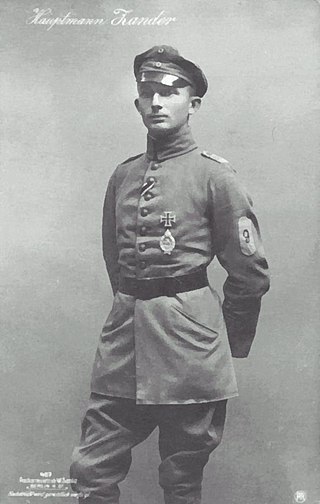Biography
See also Aerial victory standards of World War I
Hans-Georg von der Osten was born on 9 September 1895 in Witzmitz. [2]
He joined the 3rd Uhlans Regiment early in World War I, on 1 September 1914. On 1 March 1915, he was commissioned as an officer. He transferred to the Air Service on 26 February 1916. Details are lacking about his primary pilot training, but on 1 August he was posted to Fliegerersatz-Abteilung 38 (Replacement Detachment 38) as a flight leader. In November 1916, he went for advanced training to become a fighter pilot. [2]
- A restored Bristol F2B.
- An example of a Pfalz D.IIIa.
In February 1917, he began a spell as a flight instructor at Breslau before transferring to a combat unit, fighter squadron Jagdstaffel 11 on 10 August. [2] One week later, he shot down a British Bristol F.2b for his first aerial victory and his squadron's 200th. He would shoot down four more enemy airplanes during the rest of the year, with a victory over a Sopwith Camel on 15 December making him an ace. [3]
He was acting commander of the Jasta from 19 January to 16 February 1918. On 26 March 1918, he took command of Jagdstaffel 4 . On 28 March he was shot down and wounded by British fighters while flying a Pfalz D.III. He survived but saw no further action during the conflict. Hans-Georg von der Osten ended the war having been awarded both classes of the Iron Cross. [3]
On 1 September 1935, Osten joined the Luftwaffe and served on the staff of General Kurt-Bertram von Döring. [3] During World War II, he commanded all of Nazi Germany's Luftwaffe bases. [1]
He was active in veterans' reunions right up until his death on 27 March 1987. He was the penultimate survivor from his old Jagdstaffel 11. [3]


